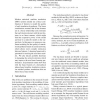Free Online Productivity Tools
i2Speak
i2Symbol
i2OCR
iTex2Img
iWeb2Print
iWeb2Shot
i2Type
iPdf2Split
iPdf2Merge
i2Bopomofo
i2Arabic
i2Style
i2Image
i2PDF
iLatex2Rtf
Sci2ools
ACL
2015
2015
Non-linear Learning for Statistical Machine Translation
Modern statistical machine translation (SMT) systems usually use a linear combination of features to model the quality of each translation hypothesis. The linear combination assumes that all the features are in a linear relationship and constrains that each feature interacts with the rest features in an linear manner, which might limit the expressive power of the model and lead to a under-fit model on the current data. In this paper, we propose a nonlinear modeling for the quality of translation hypotheses based on neural networks, which allows more complex interaction between features. A learning framework is presented for training the non-linear models. We also discuss possible heuristics in designing the network structure which may improve the non-linear learning performance. Experimental results show that with the basic features of a hierarchical phrase-based machine translation system, our method produce translations that are better than a linear model.
Related Content
| Added | 13 Apr 2016 |
| Updated | 13 Apr 2016 |
| Type | Journal |
| Year | 2015 |
| Where | ACL |
| Authors | Shujian Huang, Huadong Chen, Xinyu Dai, Jiajun Chen |
Comments (0)

